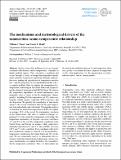| dc.contributor.author | Porter, William C. | |
| dc.contributor.author | Heald, Colette L. | |
| dc.date.accessioned | 2020-06-08T20:19:33Z | |
| dc.date.available | 2020-06-08T20:19:33Z | |
| dc.date.issued | 2019-10 | |
| dc.date.submitted | 2019-07 | |
| dc.identifier.issn | 1680-7324 | |
| dc.identifier.uri | https://hdl.handle.net/1721.1/125734 | |
| dc.description.abstract | Surface ozone (O3) pollution levels are strongly correlated with daytime surface temperatures, especially in highly polluted regions. This correlation is nonlinear and occurs through a variety of temperature-dependent mechanisms related to O3 precursor emissions, lifetimes, and reaction rates, making the reproduction of temperature sensitivities - and the projection of associated human health risks - a complex problem. Here we explore the summertime O3- temperature relationship in the United States and Europe using the chemical transport model GEOS-Chem. We remove the temperature dependence of several mechanisms most frequently cited as causes of the O3-temperature "climate penalty", including PAN decomposition, soil NOx emissions, biogenic volatile organic compound (VOC) emissions, and dry deposition. We quantify the contribution of each mechanism to the overall correlation between O3 and temperature both individually and collectively. Through this analysis we find that the thermal decomposition of PAN can explain, on average, 20 % of the overall O3-temperature correlation in the United States. The effect is weaker in Europe, explaining 9 % of the overall O3-temperature relationship. The temperature dependence of biogenic emissions contributes 3 % and 9 % of the total O3-temperature correlation in the United States and Europe on average, while temperature-dependent deposition (6 % and 1 %) and soil NOx emissions (10 % and 7 %) also contribute. Even considered collectively these mechanisms explain less than 46 % of the modeled O3- temperature correlation in the United States and 36 % in Europe. We use commonality analysis to demonstrate that covariance with other meteorological phenomena such as stagnancy and humidity can explain the bulk of the remainder of the O3-temperature correlation. Thus, we demonstrate that the statistical correlation between O3 and temperature alone may greatly overestimate the direct impacts of temperature on O3, with implications for the interpretation of policy-relevant metrics such as climate penalty. | en_US |
| dc.description.sponsorship | EPA STAR (grant no. RD-83522801) | en_US |
| dc.description.sponsorship | NIH (grant no. P30-ES002109) | en_US |
| dc.language.iso | en | |
| dc.publisher | Copernicus GmbH | en_US |
| dc.relation.isversionof | http://dx.doi.org/10.5194/acp-19-13367-2019 | en_US |
| dc.rights | Creative Commons Attribution 4.0 International license | en_US |
| dc.rights.uri | https://creativecommons.org/licenses/by/4.0/ | en_US |
| dc.source | Copernicus Publications | en_US |
| dc.title | The mechanisms and meteorological drivers of the summertime ozone–temperature relationship | en_US |
| dc.type | Article | en_US |
| dc.identifier.citation | Porter, William C. and Colette L. Heald. "The mechanisms and meteorological drivers of the summertime ozone–temperature relationship." Atmospheric Chemistry and Physics, 19 (2019): 13367-13381. © 2019 Author(s). | en_US |
| dc.contributor.department | Massachusetts Institute of Technology. Department of Civil and Environmental Engineering | en_US |
| dc.relation.journal | Atmospheric Chemistry and Physics | en_US |
| dc.eprint.version | Final published version | en_US |
| dc.type.uri | http://purl.org/eprint/type/JournalArticle | en_US |
| eprint.status | http://purl.org/eprint/status/PeerReviewed | en_US |
| dc.date.updated | 2020-05-27T17:40:52Z | |
| dspace.date.submission | 2020-05-27T17:41:02Z | |
| mit.journal.volume | 19 | en_US |
| mit.journal.issue | 21 | en_US |
| mit.license | PUBLISHER_CC | |
| mit.metadata.status | Complete | |
